DeepTrade AI - Multi-Model Stock Prediction with NLP & Automated Trading
An enterprise-grade system integrating LSTM-XGBoost prediction with sentiment analysis, distributed training infrastructure, and automated workflows
1. Overview
DeepTrade AI is an enterprise-grade automated stock trading system that combines machine learning price prediction with NLP-based sentiment analysis and distributed computing infrastructure. The system features a bidirectional LSTM with attention mechanism and XGBoost ensemble for multi-timeframe price forecasting (5m, 15m, 30m, 1h), and integrates FinBERT for real-time sentiment analysis of financial news, Reddit posts, and SEC filings. The architecture employs distributed training across 4x V100 GPUs, real-time Kafka streaming processing 9K+ financial events daily, automated Airflow workflows, and CI/CD pipeline automation. The system achieves 55-65% directional accuracy and a 58.5% win rate in paper trading with comprehensive risk management controls.
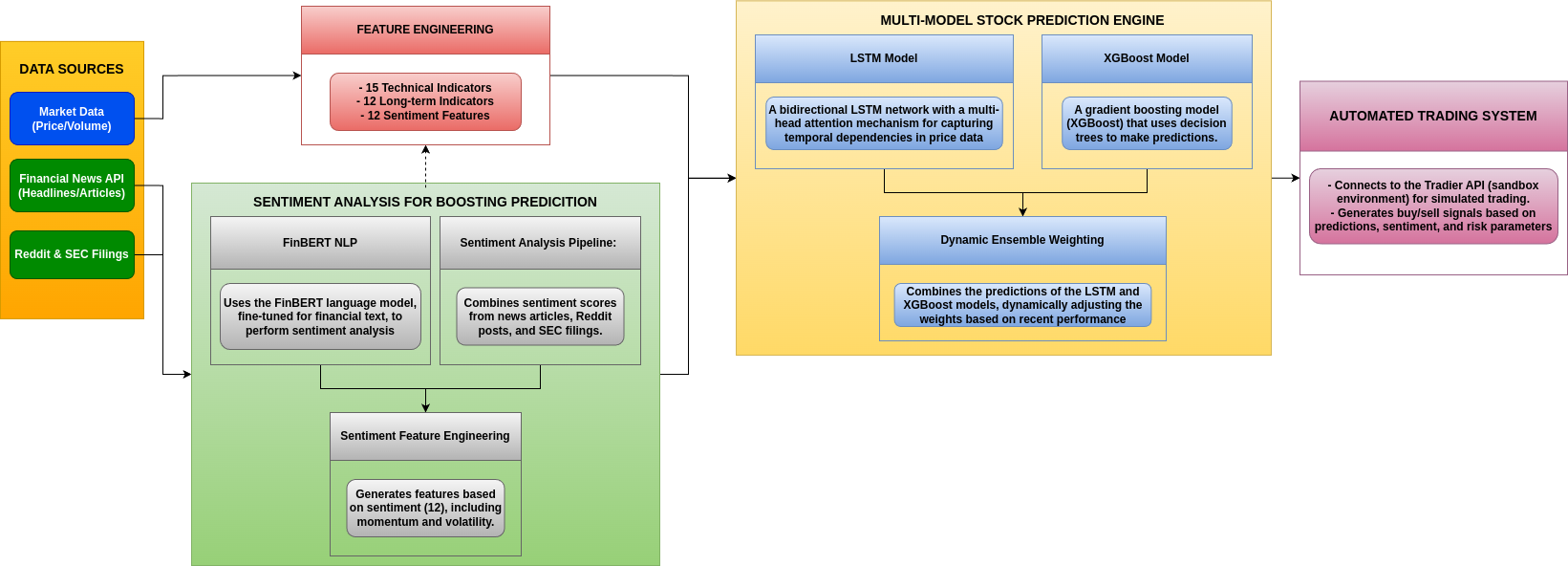
DeepTrade AI system architecture showing data flow between components
2. Infrastructure & Data Processing
DeepTrade AI leverages enterprise-scale infrastructure components to handle high-frequency financial data processing and model training:
2.1 Distributed Training Infrastructure
The system implements distributed training across multiple GPUs to efficiently train 100+ model configurations:
- Multi-GPU Training: Data parallelism across 4x NVIDIA V100 GPUs with PyTorch DistributedDataParallel
- Scale: 100 model configurations (25 stocks × 4 timeframes) trained simultaneously
- Performance: 75% reduction in training time compared to single-GPU setup
- Architecture: Master-worker setup with automatic load balancing and gradient synchronization
2.2 Real-Time Streaming Pipeline
A high-throughput Kafka streaming infrastructure processes financial data from multiple sources:
- Technology: Apache Kafka with optimized partitioning across 4 topics
- Capacity: 9,000+ financial events processed daily with sub-second latency
- Data Sources: NewsAPI, Reddit, SEC EDGAR filings, and market data APIs
- Processing: Real-time event enrichment and validation with Avro serialization
2.3 Automated Workflow Management
Apache Airflow orchestrates the entire sentiment analysis and model training pipeline:
- Workflow Automation: Directed Acyclic Graphs (DAGs) for complex task dependencies
- FinBERT Integration: Automated sentiment analysis processing every 4 hours
- Feature Generation: 12 temporal sentiment indicators with momentum tracking
- Performance: ~5% improvement in trading accuracy through automated workflows
2.4 CI/CD Pipeline Automation
GitHub Actions provides continuous integration and deployment for model lifecycle management:
- Automated Triggers: Performance degradation detection, data changes, and scheduled retraining
- Pipeline Stages: Setup → validation → training → testing → deployment
- Model Management: Automated versioning, rollback capabilities, and performance monitoring
- Deployment: <15 minutes for complete model retraining and deployment
3. Sentiment Analysis Pipeline
DeepTrade AI incorporates a sophisticated sentiment analysis pipeline that aggregates and analyzes data from three key sources:
3.1 Multi-Source Integration
-
Financial News Processing (40%): Real-time streaming with NewsAPI integration, automated headline analysis, and relevancy-based filtering
-
Reddit Sentiment Analysis (30%): Multi-subreddit monitoring (r/wallstreetbets, r/stocks, r/investing) with advanced engagement metrics and post-comment sentiment weighting
-
SEC Filing Analysis (30%): Real-time CIK tracking, form-specific sentiment weighting, and automated filing pattern analysis
3.2 FinBERT Model Architecture
The core of the sentiment analysis is a fine-tuned FinBERT model specifically pre-trained on financial text:
- Tokenization: Converts text data into numerical representations with tokens truncated at 512 length
- Three-Class Classification: Classifies sentiment as positive, negative, or neutral
- Custom Sentiment Score: Combines probabilities and source-specific weights for a composite sentiment score
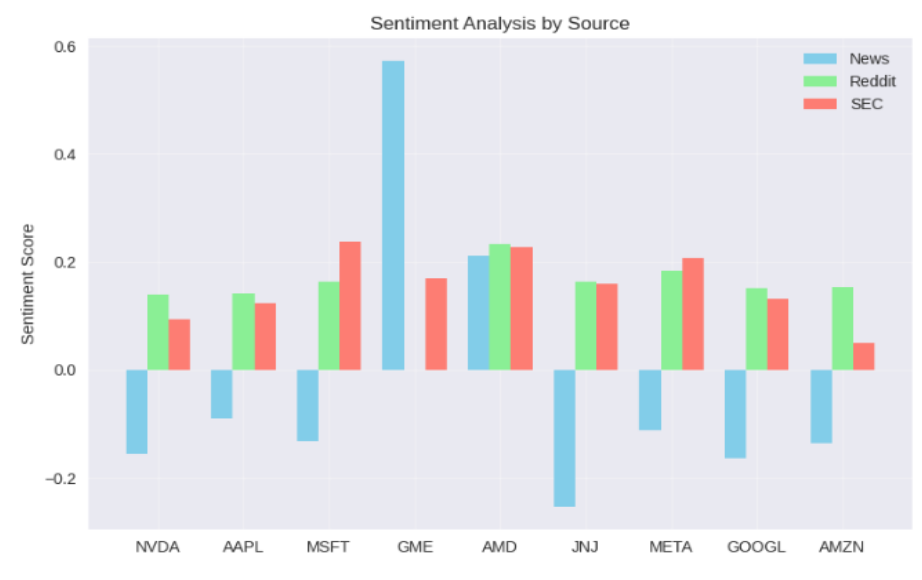
Sentiment analysis across different sources and stocks: Financial News (blue), Reddit (green), and SEC Filings (red)
4. Multi-Model Stock Prediction System
The prediction system employs an ensemble approach combining two powerful models:
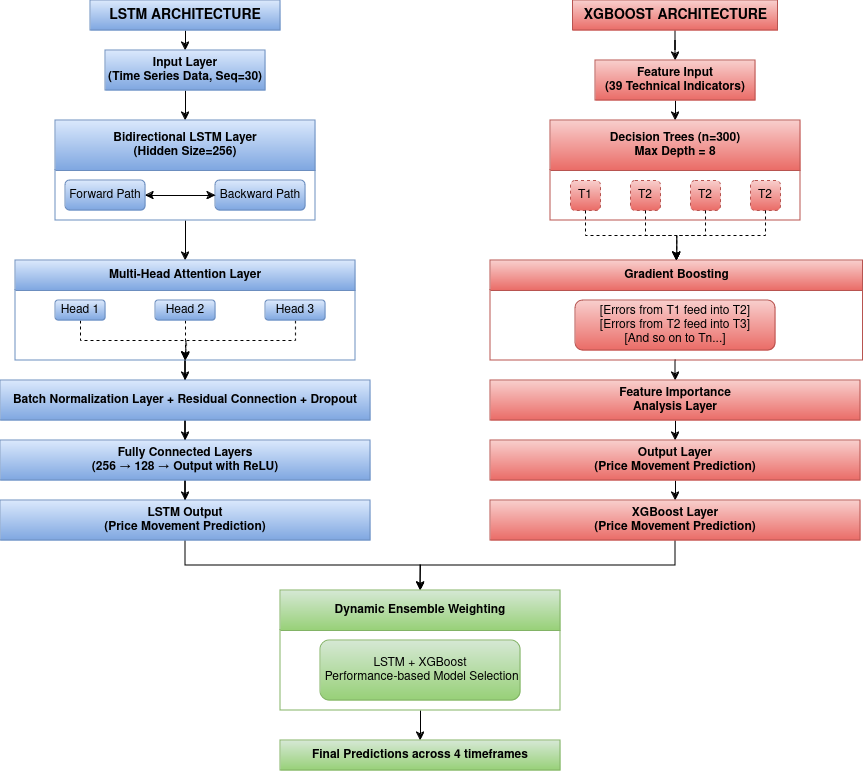
LSTM and XGBoost model architectures with dynamic ensemble weighting
4.1 LSTM Model with Attention Mechanism
The LSTM component features several advanced architectural elements:
- Bidirectional Processing: Analyzes time series data in both forward and backward directions
- Multi-Head Attention: Allows the model to focus on different parts of the input sequence with varying levels of importance
- Residual Connections and Batch Normalization: Improves training stability and convergence
- Dynamic Dropout: Adaptively adjusts regularization during training
4.2 XGBoost Model for Feature-Based Predictions
The XGBoost component complements the LSTM by providing a feature-based perspective:
- Gradient Boosting Framework: Iteratively builds an ensemble of 300 decision trees
- Advanced Feature Engineering: Processes 39 features including technical indicators, trend signals, and sentiment data
- Feature Importance Analysis: Provides insights into which factors most influence predictions
4.3 Dynamic Ensemble Integration
The predictions from both models are combined using a dynamic weighting scheme:
- Weights are adjusted based on recent performance on validation data
- Adaptive weighting responds to changing market conditions
- Better-performing model receives higher influence in final prediction
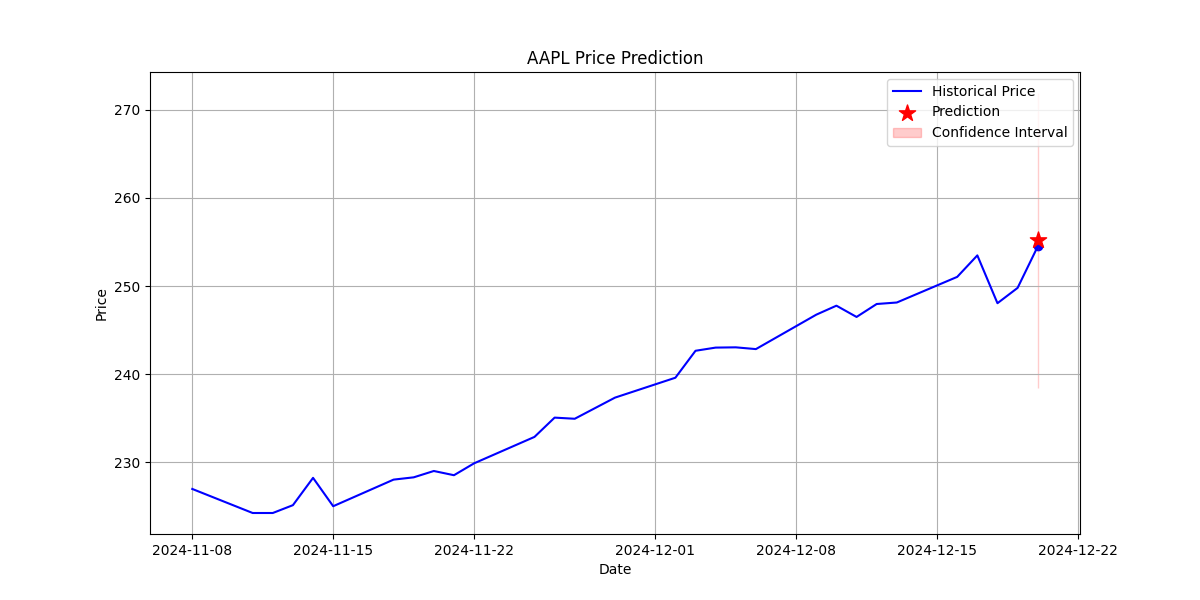
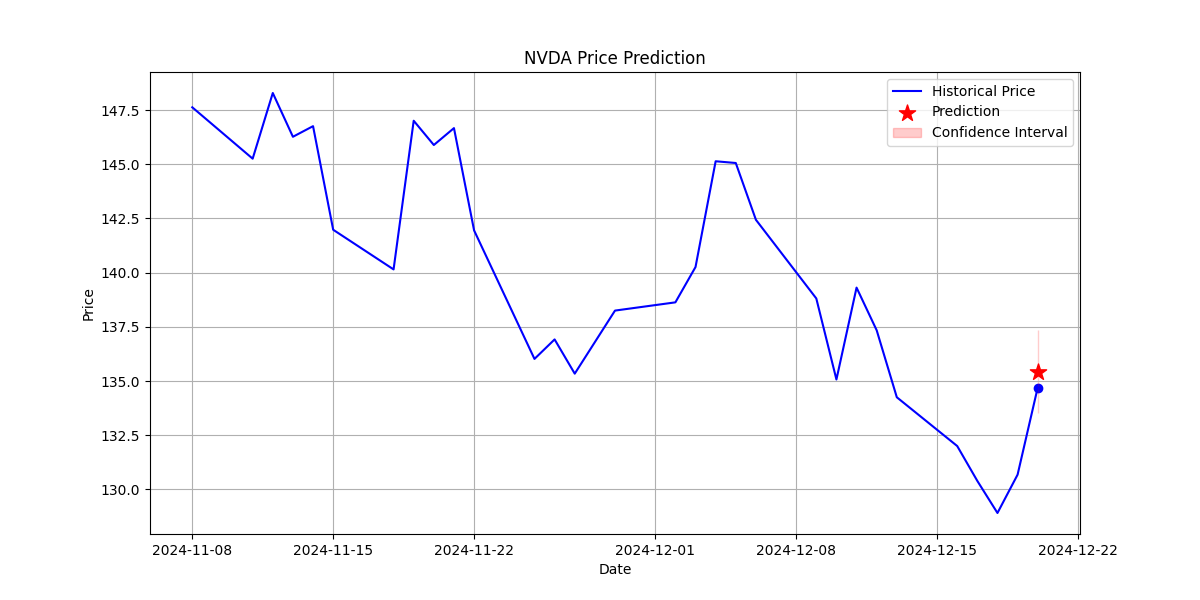

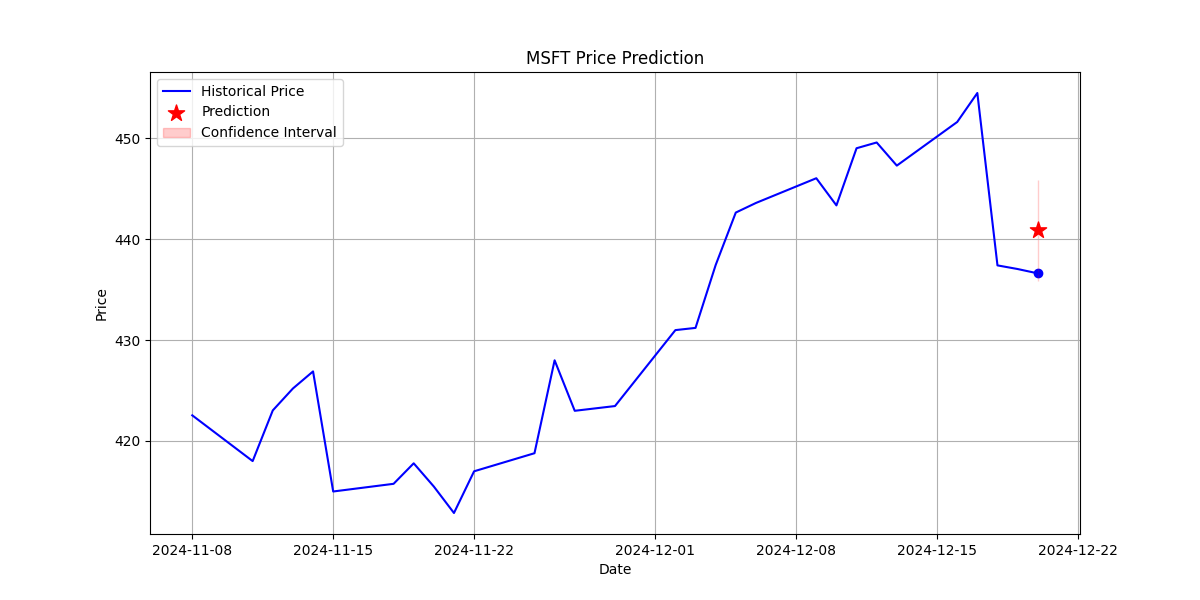
Multi-timeframe predictions across different stocks showing price action and confidence intervals
5. Automated Trading System
The trading system translates predictions and sentiment analysis into concrete trading actions through the Tradier API sandbox environment.
5.1 Trading Logic Pipeline
Prediction → Sentiment → Signal Generation → Risk Analysis → Position Sizing → Execution
↓ ↓ ↓ ↓ ↓ ↓
Price Data News/Social Trend Analysis Risk Limits Dynamic Sizing Market Orders
↓ ↓ ↓ ↓ ↓ ↓
Confidence Sentiment Entry/Exit Stop Loss Position Value Executions
Scores Scores Signals Take Profit Calculation & Monitoring
5.2 Risk Management Framework
- Maximum Concurrent Positions: Limits to 2 open trades
- Position Size: 2% of capital per trade
- Maximum Daily Risk: 2% of account value
- Stop-Loss: Automatic exit at 1.5% adverse move
- Take-Profit: Automatic exit at 3% profit target
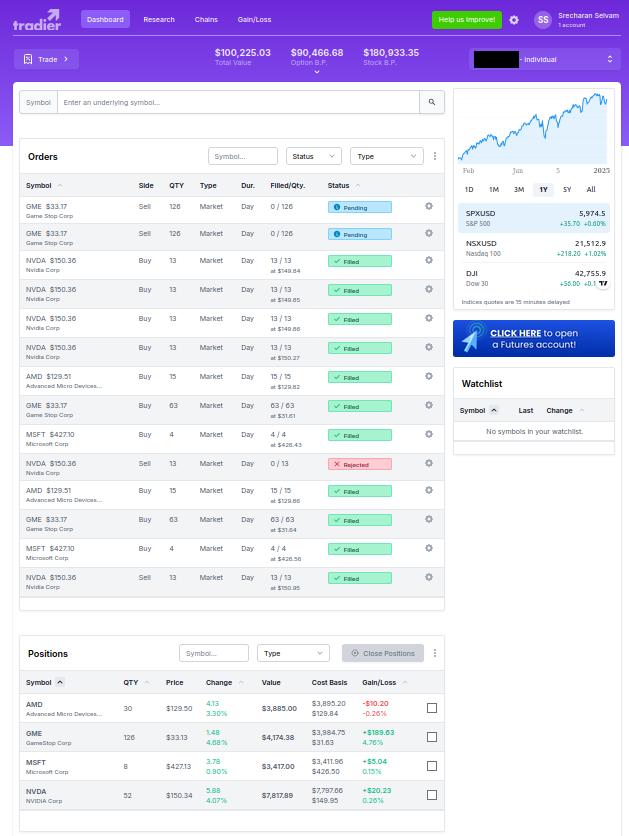
Screenshot of the Tradier paper trading interface showing successful execution of trades
6. Performance Metrics
| Metric | Value | Description |
|---|---|---|
| Directional Accuracy | 55-65% | Across all timeframes |
| Mean Absolute Error | 0.3-0.4% | On normalized returns across multiple stocks |
| Training Speed Improvement | 75% | Reduction with distributed training across 4x V100 GPUs |
| Streaming Throughput | 9K+ events/day | Real-time financial data processing capacity |
| Confidence Scoring | 87-93% | Accuracy of confidence intervals |
| Win Rate (Paper Trading) | 58.5% | Across 9 major tech and blue-chip stocks |
| Risk-Reward Ratio | 1:2 | Average risk to reward across all trades |
7. Contribution
As this was an individual project, I was responsible for the complete development of this trading system, including:
- Machine Learning: Implementing the bidirectional LSTM network with multi-head attention mechanism and XGBoost ensemble with comprehensive feature engineering
- Infrastructure: Designing distributed training infrastructure with PyTorch DDP across 4x V100 GPUs for 75% training speed improvement
- Data Engineering: Building real-time Kafka streaming pipeline processing 9K+ financial events daily with sub-second latency
- Workflow Automation: Creating Apache Airflow DAGs for automated FinBERT sentiment analysis and model training workflows
- DevOps: Implementing CI/CD pipeline with GitHub Actions for automated model lifecycle management
- NLP: Developing the FinBERT-based sentiment analysis system integrating financial news, Reddit posts, and SEC filings
- Trading System: Designing and implementing the automated trading system with comprehensive risk management and Tradier API integration
- Testing & Validation: Building comprehensive test suites and validation frameworks for all infrastructure components
8. Skills & Technologies Used
- Languages & Frameworks: Python, PyTorch, TensorFlow, CUDA, Scikit-learn, Pandas, NumPy
- Machine Learning: Gradient Boosting (XGBoost), Feature Engineering, Time Series Forecasting
- Deep Learning: LSTM Networks (Bidirectional, Attention), Model Ensembling, Hyperparameter Optimization
- Distributed Computing: PyTorch DistributedDataParallel, Multi-GPU Training, CUDA Programming
- Infrastructure: Apache Kafka, Apache Airflow, Docker, GitHub Actions CI/CD
- Natural Language Processing: FinBERT, Sentiment Analysis, Text Processing, Financial Text Mining
- Cloud Computing: AWS (GPU instances), Distributed training infrastructure
- APIs: Tradier (paper trading), NewsAPI (financial news), Reddit API (sentiment data)